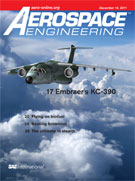Magazine

MOMENTUM: OCTOBER 2019
2019-10-01
Advanced Class Starship Georgia Tech team right on the mark with glider-deploying RC aircraft at SAE Aero Design competition. 75 points Much more time and energy go into a Formula SAE Presentation Event than one might think. Major redesign A new electronic CVT highlighted a year of major vehicle upgrades for the historically strong Baja SAE team from ETS.



















